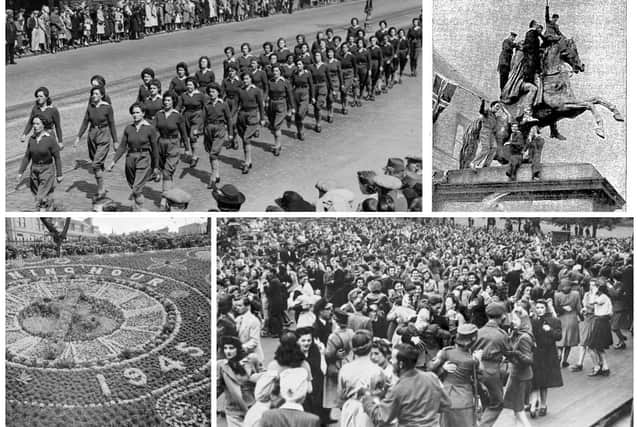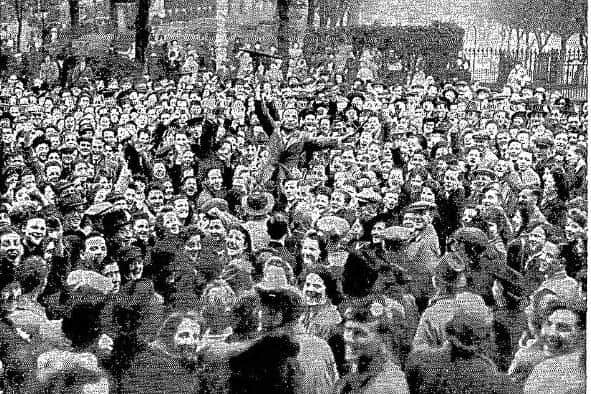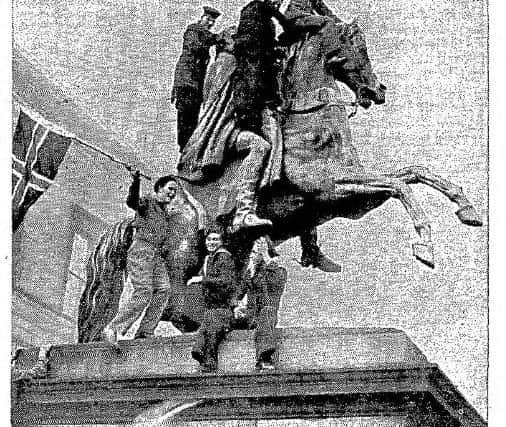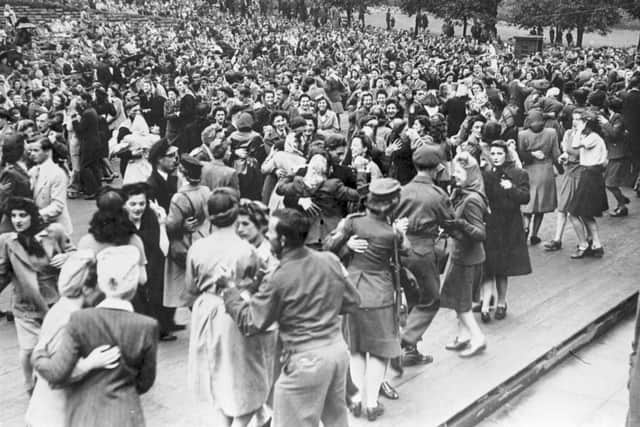VE Day 75: How Edinburgh marked the end of the war in Europe
and live on Freeview channel 276
As Winston Churchill put it, it was “the greatest outburst of joy in the history of mankind”.
But for many, the celebrations that marked the end of the war in Europe on this day 75 years ago were bittersweet.
Advertisement
Hide AdAdvertisement
Hide AdAlthough the Capital suffered mildly in comparison to the sustained raids elsewhere – being hit by only 47 high explosives compared to the 441 that ravaged Clydebank – the human toll was great.
Countless families across the city had received the dreaded telegram, informing them their beloved laddie, husband, uncle or father hadn’t made it, more than 30,000 city schoolchildren had been torn from their parents and evacuated to often far flung parts of the country, while a total of 20 people had died and 210 injured in Edinburgh on account of the Luftwaffe’s bombs.
Nevertheless, the city’s spirit was strong and scenes of jubilation broke out as news filtered through that the Allies were victorious in their efforts to end the war in Europe.
City bonfires


Edinburgh’s celebrations began on the evening of May 7 1945, in advance of official proceedings, with war-weary locals gathering all the spare wood and combustible rubbish they could get their hands on to feed huge bonfires across the city.
Advertisement
Hide AdAdvertisement
Hide AdOld Town “bairns” took “full advantage” of the permission to light bonfires, The Scotsman recorded. Canongate children built a large fire near the entrance to Holyrood Palace, where people danced to the music of the concertina.
VE Day
The following day – VE Day – witnessed an outpouring of joy in central Edinburgh.


Council leaders hosted a rather sedate official recognition of the end of the war in Europe at the City Chambers and Mercat Cross, where the Dean of the Thistle read the 76th Psalm, which had previously formed part of a service held in the same place in 1588 to mark victory over the Spanish Armada.
The city’s unofficial celebrations, however, were considerably more raucous.
Advertisement
Hide AdAdvertisement
Hide AdMay 8 and 9 were declared public holidays to mark the victory and thousands of service men and women, factory workers, shop workers and others took to the streets to dance, parade, cavort and sing together as one.
Hats were tossed skyward, Union Flags were waved and chocolate and chewing gum, courtesy of US servicemen, rained down on the assembled crowds at Princes Street where the people belted out the likes of Roll Out the Barrel and Harry Lauder’s famous ditty to defiance and determination, Keep Right On to the End of the Road.


’Mounting’ Wellington’s steed
One of the Capital’s focal points was outside Register House, where an unfathomably large number of soldiers, sailors and members of the public clamoured in perilous fashion all over the Wellington statue, waving to the crowds and catching bunnets and bowler hats.
“If no-one has fallen to his death from the Duke of Wellington’s mute charger, it has not been for want of trying,” noted one Scotsman writer.
Advertisement
Hide AdAdvertisement
Hide AdWith energy restrictions still very much in place, the city was denied the “crowning glory” of a flood-lit Edinburgh Castle, but the people more than made up for it by the noise they generated.
A mostly young crowd flooded Princes Street Gardens and the Ross Bandstand to take their partners by the hand and dance eightsome reels and other jigs to the sound of amplified music from the wireless.
Thanksgiving Sunday parade


On the Sunday, Edinburgh witnessed one of its greatest ever crowds for the Thanksgiving Parade, with 3000 men and women, representing the Services, Civil Defence workers, war workers and youth organisations, marching the length of Princes Street.
Street parties were numerous. At Stockbridge’s colonies and elsewhere locals assembled long trestle tables, decorated buildings in flags and bunting and ate, danced and sang to their hearts content.
Advertisement
Hide AdAdvertisement
Hide AdOne Glenogle Road resident recalled: “The children were all in one street for their tea and in the evening we waltzed in the street.”
Another said: “When the war finished, everybody made for Princes Street. It was absolutely packed. You could hardly move in it with the people singing and the jollification.
“There was no drinking, though. Everybody was high on the fact that the war in Europe had ended.”
While the Capital, like elsewhere in Britain and Europe, was fully inebriated by the intoxicating fumes of victory, the feeling of optimism was temporary.
Advertisement
Hide AdAdvertisement
Hide AdVE Day, and later that summer, VJ Day, may have marked the end of conflict, but in some ways the war continued.
Millions of loved ones had been lost, while restrictions such as wartime rationing would continue until 1954 and the country also faced a dire housing shortage – Edinburgh alone was short of 10,000 homes.
After VE Day began the slow task of rebuilding a country that had ground to a halt in its desperate bid for survival for the best part of a decade.
City’s congratulatory telegram to Winston Churchill
On the day the war ended in Europe, Edinburgh’s Town Council sent out telegrams, expressing the city’s pride, gratitude and sense of shared accomplishment, to Prime Minister Winston Churchill and His Majesty the King.
Advertisement
Hide AdAdvertisement
Hide AdThe telegram sent to Mr Churchill read as follows: “Edinburgh offers to you her heartfelt thanks and congratulations upon the achievement of this triumphant conclusive victory. She expresses to you the pride she feels in what has been accomplished by one of her Burgesses and her gratitude for your inspiration and guidance during the most critical years in the history of our nation.”
Edinburgh’s message to King George VI and Queen Mary read: “The Lord Provost, Magistrates and Council, and the citizens of Edinburgh present their humble duty to Your Majesties and offer their heartfelt congratulations upon the triumphant victory achieved in Europe.
“They express their warmest gratitude for the valour with which Your Majesty’s Forces have overcome tremendous odds.”
A message from the Editor:Thank you for reading this story on our website. While I have your attention, I also have an important request to make of you.With the coronavirus lockdown having a major impact on many of our advertisers - and consequently the revenue we receive - we are more reliant than ever on you taking out a digital subscription.Subscribe to scotsman.com and enjoy unlimited access to Scottish news and information online and on our app. With a digital subscription, you can read more than 5 articles, see fewer ads, enjoy faster load times, and get access to exclusive newsletters and content. Visit https://www.scotsman.com/subscriptions now to sign up.
Advertisement
Hide AdAdvertisement
Hide AdOur journalism costs money and we rely on advertising, print and digital revenues to help to support them. By supporting us, we are able to support you in providing trusted, fact-checked content for this website.
Joy Yates
Editorial Director
Comment Guidelines
National World encourages reader discussion on our stories. User feedback, insights and back-and-forth exchanges add a rich layer of context to reporting. Please review our Community Guidelines before commenting.